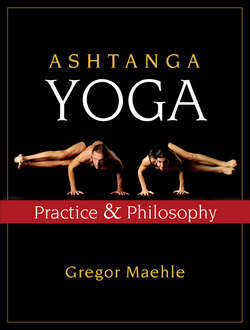Читать книгу Ashtanga Yoga - Gregor Maehle - Страница 28
Samasthiti
ОглавлениеEQUAL STANDING
Drishti Nose
Samasthiti is the basic standing posture. We stand with the base of our big toes touching and the heels slightly apart so that the feet are parallel. The straight line of the foot is from the second toe to the center of the heel. If we were to bring the heels together, the thighbones (femurs) would be outwardly rotated to a slight extent.
We start by establishing Ujjayi breathing with a smooth and even sound. The rib cage expands evenly in all four directions, and the bandhas are consciously engaged if they have not automatically been initiated with the breath. The inhalation reaches down in front of the spine and hooks into the pelvic floor, creating a lifting sensation from the center of the perineum (Mula Bandha). At the same time, the lower abdominal wall, between the navel and the pubic bone, gently draws in toward the spine. The natural up-and-down movement of the diaphragm and the accompanying movement of the upper abdomen or stomach area are unrestricted.
The toes spread as one would spread one’s fingers, in order to completely awaken the feet. The weight of the body is placed above the ankles and equally distributes to all four corners of the feet — the bases of the large and little toes and the inside and outside edges of the heels. The body weight is also evenly distributed between the inner and outer arches of the foot, while the arches are lifted and active. The action of the toes influences the pubic bone while the heels relate to the tailbone (coccyx).
The fronts of the thighs are contracted, with the quadriceps pulling up the kneecaps. Quadriceps means four heads, referring to the four points of origin of this large muscle group. All four heads join into the common quadriceps tendon, which leads down to the shin. The kneecap (patella), a floating bone, is embedded within it.
Many students will have to tilt the pelvis posteriorly (backward), which reduces any excess curvature in the low back and makes one stand taller. This movement is achieved by engaging the abdominal muscles, which lifts the pubic bone as the coccyx drops. The strength of the legs creates a vector of energy whose resonance is felt up the entire length of the body’s core.
